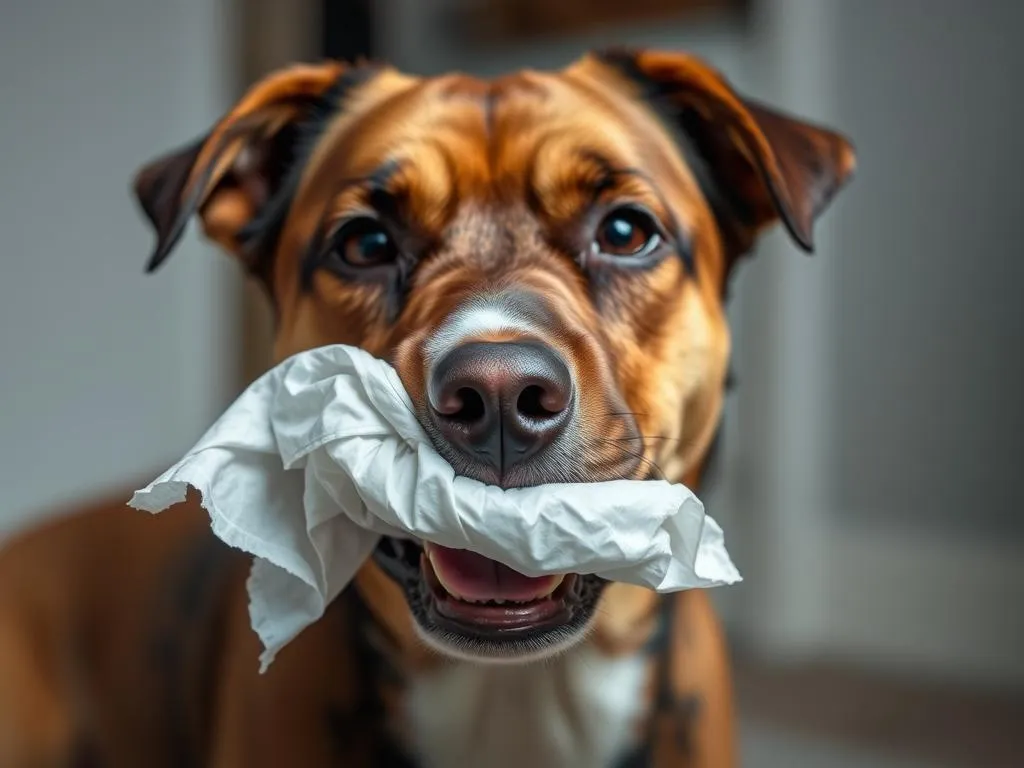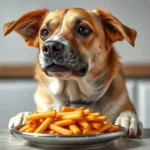
Dog nutrition is a vital aspect of pet ownership that can significantly impact your furry friend’s overall health and well-being. A balanced diet tailored to a dog’s specific needs helps maintain their energy levels, promotes a healthy coat, and supports their immune system. However, pet owners often encounter puzzling behaviors, such as their dog’s tendency to consume non-food items. One common concern is: why does my dog eat tissues? Understanding the reasons behind this behavior can help you address it effectively.
In this article, we will explore the nutritional needs of dogs, delve into behavioral reasons for eating tissues, identify potential health risks, and provide strategies for prevention. Additionally, we will offer alternatives to satisfy your dog’s chewing instincts without resorting to tissues.
Understanding Canine Nutrition
Nutritional Needs of Dogs
Every dog has unique nutritional requirements based on factors such as age, breed, and health status. Essential nutrients include:
- Proteins: Vital for growth, muscle development, and tissue repair.
- Fats: Provide energy and support healthy skin and coat.
- Carbohydrates: Offer a source of energy and aid in digestive health.
- Vitamins and Minerals: Required for various bodily functions, including bone health and immune system support.
Puppies require a different balance of these nutrients compared to adult dogs, and senior dogs may need specific dietary adjustments to address age-related health issues. Therefore, it’s crucial to select a diet that fits your dog’s life stage and individual needs.
Common Myths About Dog Nutrition
Many misconceptions about dog nutrition persist among pet owners. For instance, a common myth is that dogs are carnivores. In reality, dogs are omnivores, meaning they can thrive on a diet that includes both animal and plant-based foods. It’s essential to provide a balanced diet that encompasses a variety of nutrients to ensure your dog remains healthy.
Behavioral Reasons for Eating Non-Food Items
Pica in Dogs
One potential explanation for why dogs eat tissues is a condition known as pica. Pica is characterized by the compulsive consumption of non-food items, which can include anything from fabric to dirt. Dogs suffering from this condition may show signs of distress and discomfort, and it can lead to serious health complications.
Symptoms of pica can include:
– Vomiting or diarrhea
– Abdominal pain
– Lack of appetite
– Lethargy
If your dog exhibits these symptoms regularly, it’s crucial to consult a veterinarian for guidance.
Reasons Dogs Eat Tissues
So, why do dogs specifically seem attracted to tissues? Several factors may contribute to this behavior:
-
Curiosity and Exploration: Dogs are naturally curious creatures. The act of tearing apart tissues can be stimulating and entertaining for them, much like playing with a toy.
-
Scent and Texture Appeal: Tissues often carry interesting smells, especially if they have been used. The texture can also be appealing for some dogs, making them irresistibly tempting to chew on.
-
Behavioral Issues: Boredom or anxiety can lead dogs to seek out alternative sources of stimulation, including non-food items like tissues. Dogs left alone for long periods may resort to chewing on whatever they can find.
Health Implications of Eating Tissues
Potential Risks
While the occasional consumption of tissues may not seem alarming, there are several potential health risks associated with this behavior:
-
Digestive Blockages: Tissues can accumulate in a dog’s digestive tract, leading to blockages that may require surgical intervention.
-
Toxicity from Materials: Some tissues may contain dyes or chemicals that can be harmful to dogs. Ingesting these substances can lead to poisoning or gastrointestinal issues.
-
Risk of Choking: Small pieces of tissue can pose a choking hazard, especially for smaller dog breeds.
Signs to Watch For
If your dog has consumed tissues, it’s important to monitor their behavior for any signs of distress or discomfort. Symptoms to look out for include:
- Vomiting
- Diarrhea
- Lethargy
- Loss of appetite
- Abdominal swelling or pain
If you notice any of these signs, it’s advisable to consult with a veterinarian promptly.
Preventing Tissue Eating Behavior
Understanding Your Dog’s Needs
The first step in preventing your dog from eating tissues is to understand their needs. Boredom is often a significant factor in this behavior. To combat boredom, ensure your dog receives regular mental and physical stimulation through:
- Daily walks
- Interactive playtime
- Training sessions
Training Techniques
Positive reinforcement is a powerful tool in shaping your dog’s behavior. Instead of punishing your dog for eating tissues, focus on redirecting their attention to appropriate chew toys. Here are some effective training techniques:
-
Command Training: Teach commands like “leave it” or “drop it” to help your dog learn to avoid non-food items.
-
Reward Good Behavior: Whenever your dog opts for a toy instead of a tissue, reward them with praise or treats to reinforce the desired behavior.
Environmental Management
Creating a safe and engaging environment can significantly reduce the likelihood of tissue-eating behavior. Consider these tips:
-
Keep Tissues Out of Reach: Store tissues, toilet paper, and other tempting items in cabinets or high places where your dog cannot access them.
-
Provide Engaging Alternatives: Offer a variety of chew toys and puzzle feeders that keep your dog occupied and satisfy their chewing instincts.
Alternatives to Tissues for Chewing
Safe Chew Toys
When it comes to satisfying your dog’s urge to chew, providing safe alternatives is key. Here are some types of chew toys that are safe for dogs:
-
Rubber Chew Toys: Durable and designed for aggressive chewers. Brands like KONG offer toys that can be stuffed with treats for added engagement.
-
Nylon Bones: Long-lasting and great for maintaining dental health.
-
Dental Chews: Specifically designed to promote oral hygiene while providing a satisfying chewing experience.
Homemade Treats
Incorporating homemade treats into your dog’s diet can also help redirect their chewing behavior. Here are a couple of simple recipes:
- Peanut Butter and Pumpkin Treats:
- Ingredients: 1 cup of peanut butter, 1 cup of canned pumpkin, 2 cups of whole wheat flour.
-
Directions: Mix ingredients, roll into small balls, and bake at 350°F for 20 minutes.
-
Sweet Potato Chews:
- Ingredients: 1 large sweet potato.
- Directions: Slice sweet potato into thin strips and bake at 250°F for 3 hours until they are chewy.
Always remember to introduce new treats in moderation to maintain a balanced diet.
Conclusion
In summary, understanding why does my dog eat tissues involves a combination of nutritional insights and behavioral understanding. By addressing nutritional needs, debunking myths, and recognizing the underlying reasons for tissue consumption, you can take proactive steps to promote your dog’s health and well-being. Monitoring your dog’s behavior and providing appropriate alternatives can help reduce this behavior while ensuring they lead a balanced and fulfilling life.
If your dog continues to exhibit pica or shows signs of distress after eating tissues, it’s crucial to consult with a veterinarian. Your furry friend deserves the best, and with the right care and attention, you can help them thrive.
FAQs
Why does my dog prefer tissues over their food?
Dogs may prefer tissues due to their scent, texture, or simply as a form of entertainment. If your dog is not eating their food, it may be a sign of an underlying issue that needs addressing.
Can eating tissues harm my dog?
Yes, consuming tissues can lead to digestive blockages, toxicity from dyes or chemicals, and choking hazards. It’s essential to monitor your dog’s behavior and consult a veterinarian if needed.
How can I stop my dog from eating tissues?
Provide engaging alternatives, keep tissues out of reach, and utilize positive reinforcement training to redirect your dog’s chewing behavior.
Are there specific dog breeds more prone to pica?
While any dog can develop pica, certain breeds known for their curious and high-energy dispositions, such as terriers, may be more prone to this behavior.
What should I do if my dog eats a large amount of tissue?
If your dog has ingested a significant amount of tissue, monitor them for symptoms of distress or discomfort. If they exhibit any concerning signs, consult a veterinarian immediately.









